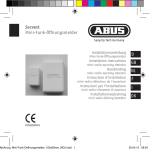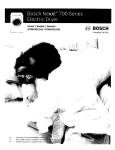Download Sennheiser MD 908 User's Manual
Transcript
!ZJ SEI\II\IHEISER BEDIENUNGSANLEITUNG USER'SGUIDE MODED'EMPlOl SCHWANENHALS-RICHTMIKROFON GOOSE NECKDlRECTIONAl MICROPHONE MICROPHONE DlRECTIONNEl ACOlDECYGNE MD 908 Richtdiagramm Polar Diagram 60" Diagramme de directivite 90. 2000", 4000", - 8000", - 16000", - ,- 180" Abb.3 Fig.3 Beschaltung/Wiring/Cäblage r I I MD908 l : I I T"'" MD 908 I I I I I ,~~~~ l__- ---~_J ,-1"" sw black noir ;:) rt red rouge f max,23mm 0'J " I I I " Fig. 1 <9) , ' I I 0 Abb.1 , I I I Abb.2 Fig.2 I I I I' I MD 9O8-U I I I I rt bl + red blue + rouge bleu + I I I I I I sw/blacklnoirI' 3poL XLR-3-Stecker 3-pm Cannon connector Fiche tripolaire XLR-3 SCHWANENHALS-RICHTMIKROFON MD908 Einleitung Das Schwanenhals-Richtmikrofon MD 908 findet nicht nur als Redner-, Ruf- oder Kommandomikrofon, sondern auch in ElaAnlagen und bei Jazz-Bands als Musikermikrofon Verwendung. Seine besonderen Vorzüge sind der weite Übertragungsbereich, die ausgeprägte Richtcharakteristik und ein knackfreier Reedkontakt-Schalter. Durch den langen Schwanenhals und ein zusätzliches 180°-Gelenk (nur MD 908-U) läßt sich das Mikrofon zu allen Seiten schwenken. Die elastische Lagerung der Mikrofonkapsel sorgt dafür, daß Trittschall-, Griff- und Hantierungsgeräusche stark abgeschwächt werden. Bei einem eventuellen Sturz oder Schlag verhindert ein Stützkorb in der Einsprache, daß das Wandlersystem Schaden nimmt. Zur Vermeidung magnetischer Störeinflüsse ist die Mikrofonkapsel mit einer Kompensationsspule ausgerüstet. Ausführungen MD 908 Das MD 908 besitzt keinen Ein- und Ausschalter und kein Gelenk. Das Anschlußkabel hat eine Länge von 1,5 m und freie Kabelenden. Am unteren Ende des Schwanenhalses befindet sich ein Anschlußstück mit einer 3/s"-Gewindebohrung. Zum Lieferumfang gehört der Anschraubsockel MZT 14 für feste Tischmontage. Besprechungsrichtung Das MD 908 besitzt eine Nierencharakteristik. Das Richtungsmaß beträgt bei 180° und 1 kHz 18 dB/- 3 dB. Das bedeutet: Trifft der Schall von hinten (180O-Richtung) auf das Mikrofon, tritt am Mikrofonausgang eine um 18 dB geringere Ausgangsspannung auf als bei Schalleinfall von vorn. (Abb.3) Aufstellen des Mikrofons Das MD 908 ist zusammen mit dem Tischfuß MZT 14 für die Tischmontage vorgesehen. Die Montage erfolgt nach Abb. 1. Die 3;g"-Gewindebohrung im Anschlußstück des Mikrofons ermöglicht auch die Montage auf Tischklemmvorrichtungen und Tischfüße mit 3/s"-Gewinde. Die Mikrofone MD 908 N und MD 908-U sind im Gelenkteil ab Werk mit einem 3;g"-Gewinde ausgestattet. Das Gewindestück kann mit Hilfe einer Münze herausgeschraubt werden. Wird es umgekehrt wieder eingesetzt, kann das Mikrofon für Stative usw. mit 1/2"-Gewinde benutzt werden. Wird das Gewindestück ganz entfernt, ist das Mikrofon zum Montieren auf 5;g" x 27 G/"-Gewinde vorbereitet (Abb.2).' MD 908-U Das MD 908-U ist mit einem 3poligen Cannon-Stecker (XLR) ausgestattet und nach Schaltschema -U beschaltet. Frequenzkurve Anschluß des Mikrofons Das MD 908 hat eine Impedanz von 200 Q und ist symmetrisch beschaltet. Es kann sowohl an symmetrische als auch an unsymmetrische Geräteeingänge angeschlossen werden. Die Abschlußimpedanz ~ Impedanz des Mikrofoneinganges sollte 200 Q nicht unterschreiten. mV/ Z" Technische Daten Akustische Arbeitsweise Ubertragungsbereich Richtcharakteristik ...... Richtungsmaß bel 1SO' und 1000 Hz . Feld-Leerlaut-Übertragungsfaktor 1000 Hz Elektrische Impedanz bel 1kHz. Minimale Abschlußimpedanz....... Magnetfeld-Störfaktor Stecker: MD 90S-U Steckerbeschaltung: Abmessungen bis 16 kHz ............ MD 90S-U Druckgradlentenempfänger 50 Hz-15000 Hz Niere 1SdB/-3 dB bel 1,3 mV/Paet3 dB (~- 77 dBV) 200Q 200Q ~ 5 flV/5 flT 3paiiger Cannan XLR-3 2 und 3 ~ Tauchspule 1 und Gehäuse' Masse kopf: 45 mm 0 52mm Hals: 11 mm 0 Gesamtlänge 440 mm 350 mm (MD 90S) Änderungen, vor allem zum technischen Fortschritt, vorbehalten. GOOSE-NECK DIRECTIONAL MICROPHONE MD 908 Directional properties The MD 908 has a cardioid directional characteristic. The Introduction The directional goose-neck microphone MD 908 is not only used for conferences, orders or announcements, but also for electroacoustic systems and as a musician' s microphone for jazz bands. Its particular advantages are the broad frequency response, pronounced directional effect (cardioid) and a clickfree Reed contact switch. The long goose neck and an additiona1180° swivel mount (only MD 908-U) enable the microphone to be angled in any direction. The microphone capsule's spring suspension ensures that impact and handling noises are reduced conciderably. If it is dropped or banged, a supporting device in the sound inlet prevents the transducer from being damaged. The microphone capsule is equipped with a compensation coi! to prevent magnetic disturbances. directionalindexat 1800and 1000 Hz is at least 18 dB / - 3 dB. This means, sound from the rear with a frequency of 1000 Hz produces an 18 dB lower signal voltage at the microphone output than sound of the same intensity reaching the micraphone fram the front. (Fig. 3) ] Types MD 908 Mounting the microphone The MD 908 is assigned for desk mounting with the screw-on socket MZT 14 (Fig. 1). The 3/8" thread in the connection link allows mounting onto a table clamp or a table stand with 3/8" thread. The hinge at the MD 908 N and MD 908-U is manufactured and designed for utilization on table clamps etc. providing the internationally most customary 3;g" thread. If the changing thread is screwed off by means of a coin and screwed in again upside down, the changing thread fits to 1/2" threads. By removing the changing thread completely the microphone is prepared to fit to 5;g" x 27 G/" threads (Fig. 2). The MD 908 has no on-off switch and no hinge. The 1.5 m long connection cable shows free lead-ends. A connection link with a 3/8" thread is fixed to the lower end of the goose neck. The micraphone will be delivered with the screw-on socket MZT 14 for permanent table installation. MD 908-U Frequency Response The MD 908-U is pravided with a 3-pin Cannon-connector (XLR) and wired according to diagram -U. -- m / Connecting the microphone The MD 908 is balanced and has an electrical impedance of 200 Q. It can be connected to both balanced and unbalanced inputs. The minimal load impedance resp. input impedance of the microphone input shouldn't be less than 200Q. 2 .ce - .. 0 "00 ,., Technical Data Acoustieal mode of operation Frequency response ~ Direetionalcharaetenstlc "'" Rejectlonat 1800 and 1kHz.. Sensitivityat 1 kHz .......... Eiectncalimpedaneeat 1 kHz Minimal ioad impedance.... Magnetiefieiddlsturbanee Connector: MD 908-U Winng:MD 908-U.. pressure gradient transducer 50 Hz-15 000 Hz cardioid 18dB/-3dB 1,3 mV/Pa I 3 dB (Q - 77 dBV) 200Q 200Q ~5IN/5~T . 3-pln Cannon connector XLR-3 2 and 3 moving coil 1and chassis ~ ground Dimensions In mm sound inlet: 45 0 length: 52 goose neck: 11 0 campiete iength: 440 mm 350 mm (MD 908) We reserve the right to aiter speciflcatlons Improvements in partleuiar wlth regard 10technlcel = = = MICROPHONE DIRECTIONNEL A COL DE CYGNE MD 908 Introduction Le microphone directionnel MD 908 a col de cygne est non seulement utilise comme microphone de conference, d' ordres ou d' appel, mais aussi comme micro pour musiciens pour la sonorisation et les enregistrement d' orchestre de jazz. Ses avantages particuliers sont la large bande passante, la directivite prononcee (cardio'i'd),contacts Reed sans bruit de friture. Grace au long col de cygne et a la jointure 180° supplementaire (seulement pour le version MD 908-U), le microphone est orientable dans toutes directions. Protection efficace contre: les champs magnetiques parasitaires par une bobine de compensation, les chocs mechaniques par un support dans la pavillon, la conduction du son par le corps par une installation elastique. Directivite La directivite du MD 908 est cardio'ide. Le degre de directvite est de 18 dB / - 3 dB pour 1800 et 1000 Hz. Cela signifie: Si I'evenement acoustique vient de I'arriere (180°) vers le micro, la tension de sortie provoquee ainsi, est inferieure de 18 dB a la tension produite par une onde touchant le micro dans la direction de reference de 0° (Fig. 3). Mise en place du microphone Le MD 908 et le pied de table MZT 14 sont prevus pour une installation sur table. (Procedez selon la fig. 1). Le filetage"ls" dans I'element de raccord du micro permet aussi la fixation du micro ades pinces de fixation et pieds de table a taraudage 3/8'" Les jointures des micros MD 908 N et MD 908-U sont equipes, depart usine, d'un filet "Is". L'element a filet peut etre enleve a I'aide d'une piece de monnaie. Si on le remet inversement, le micro peut etre utilise pour des pieds etc. a filet 1/2'" Si on enleve completement I'element a filet, I'element de raccord est pret a etre monte sur un filet %" (Fig. 2). Versions MD 908 Le MD 908 est sans commutateur marche-arret et sans Jointure. Le cable de raccordement a une longueur de 1,5 m, les extremites du cable sont libres. L'extremite inferieure du col de cygne possede un element de raccordement avec un taraudage 3/8'" La livraison comprend le socie avis MZT 14 pour une fixation rigide sur table. MD 908-U Le MD 908-U est equipe du connecteur Cannon tripolaire (XLR) et branche selon le schema -U. Courbe de reponse Branchement du microphone Le MD 908 a une impedance de 200 Q et est branche symetriquement. 11peut etre branche ades appareils ayant une entree symetrique ou asymetrique. L'impedance 2"" terminale impedancede I'entreedu microphonene devraitpas depasser200 Q ~ Caracteristiques techniques Principeacoustique Bande passante Dlrectivlte . . . ......... Degrede directivitea 1800el 1000 Hz . Sensibilltea1000Hz .. capteur de gradient de pression 50 Hz-15000 Hz cardioide 18 dB-3 dB 1,3 mViPact 3 dB (Q - 77 dBV) 200Q Impedanceelectriquea 1000 Hz impedanceminimaiedecharge......... Sensibiliteaux champs magnetiques.. Fiches:MD908-U........ Connecteur:MD 908-U . tripolaire Cannon XLR-3 2 et 3 ~ bobine mobiie Dimension en mm .. paviilon: 450 200Q ~5 ~Vl5 ~T 1et boitier ~ masse langueur: 52 coi de cygne longueurtotale: 11 0 440 350 (MD 908) Modifications, surtout dans i'interet du progres technique, reservees. SENNHEISER ELECTRONIC KG. 0-30900 WEOEMARK TELEFON 051 30/600-0 TELEX 9 24 623 TELEFAX 0 51 30/6312 Printed in GermanyPubl. 10/93 18255/A04
This document in other languages
- français: Sennheiser MD 908
- Deutsch: Sennheiser MD 908













